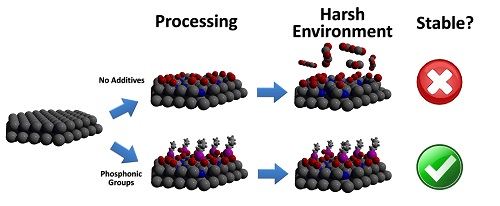Researchers from North Carolina State University have developed a new processing technique that makes light emitting diodes (LEDs) brighter and more resilient by coating the semiconductor material gallium nitride (GaN) with a layer of phosphorus-derived acid.
“By coating polar GaN with a self-assembling layer of phosphonic groups, we were able to increase luminescence without increasing energy input,” says Stewart Wilkins, a Ph.D. student at NC State and lead author of a paper describing the work. “The phosphonic groups also improve stability, making the GaN less likely to degrade in solution.
 |
|
By coating polar gallium nitride with phosphonic groups, the researchers increased luminescence without increasing energy input. |
“Making the GaN more stable is important,” Wilkins adds, “because that makes it more viable for use in biomedical applications, such as implantable sensors.”
The researchers started with polar GaN, composed of alternating layers of gallium and nitrogen. To increase luminescence, they etched the surface of the material with phosphoric acid. At the same time, they added phosphonic groups – organic molecules containing phosphorus – that self-assembled into a monolayer on the surface of the material. This layer further increased luminescence and improved the stability of the GaN by making it less likely to react chemically with its environment.
The paper, “In Situ Chemical Functionalization of Gallium Nitride with Phosphonic Acid Derivatives during Etching,” is published online in the journal Langmuir. Senior author of the paper is Dr. Albena Ivanisevic, an associate professor of materials science and engineering at NC State and associate professor of the joint biomedical engineering program at NC State and the University of North Carolina at Chapel Hill. The paper was co-authored by Dr. Consuelo Arellano, a research associate professor of statistics at NC State; Dr. Tania Paskova, a research professor of electrical and computer engineering at NC State; and Michelle Greenough, an undergraduate at Wagner College.
The research was supported in part by the National Science Foundation under grant EEC 1156762.












